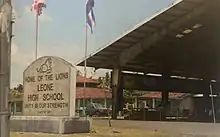Tualatai County
Tuālā-tai County is one of the five counties that make up the Western District (le Falelima i Sisifo) of American Samoa.[1]
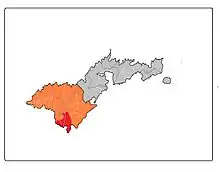
The other four are Ālātaua, Fofō, Leāsina (Aitūlagi) and Tuālā-uta (Ma’upū).
The villages of Fūtiga, Itū'au (Malaeloa), Taputimu and Vailoatai form the itūmālō (county/district) o Tuālātai. Vailoatai serves as the county’s principality as the titular head of the district (fa'asuaga) is located here.
The county is represented by one senator in the American Samoa Senate and by one representative in the American Samoa House of Representatives.
It is the fourth most populous county of American Samoa as of 2010.
Etymology
Tuālātai / Tuālā-tai[2]
Tuālā, v. to put a canoe more before the wind; n. the back of a sail.[3][4] The ‘tai’ suffix designates this county as being the Tuālā county on the side towards the sea, whereas Tuālā-uta is the Tuālā county on the side towards the land or inland.
During Sāmoa's pre-1900 history, Tuālā-tai and Tuālā-uta formed an usoga (alliance) that represented the larger Aitūlagi community in times of war.[5][6] Tuālā-tai was assigned as the itū’au (controller of troops[7]) whereas Tuālā-uta was designated as the alātaua (director of wars[8]).
The assumption of these war-time roles by allied villages or districts was a common practice throughout pre-contact Samoa[9][10] with its roots in the first Mālietoa government.[11] The last intra-island conflict in which these two counties went together into battle took place in 1892.[12][13]
In the high titles of ceremony, the salutation, Fofō ma Aitūlagi, stands for the entire Western District of Tutuila[14] (le fa'alupega o le Falelima i Sisifo[15]).
Fofō is home to Leone and all of the Ālātaua villages west of it.[16]
Aitūlagi is the name of the famed family of high orator chiefs (tama matua)[17] from the Malaeloa town of the same name within Leāsina county.
When Leāsina, Tuālā-tai and Tuālā-uta counties are placed as Aitūlagi opposite of Fofō, they are then called Ma'upū by way of contrast.[18][19]
Ma'upū, n. a sister's son (man speaking), a privileged relationship;[20] a title that originated from another village.[21]
Fa'alupega: The Charter of Tuālātai[22][23]
Afio Sātele ma alo o Fānene
Susū le matua ma le falefia o ali'i
Maliu mai tauto'oto'o
Mamalu o Faleālili ma le faletolu ma le fetalaiga a Itū'au
Legends
In the book, Ole Manuō o Tala Tu’u ma Fisaga o Tala Ave, the village of Vailoa defeated the cannibal king Tuife’ai with the assistance of two brothers from Ātua,[24] Chiefs Lutu and Solosolo.[25]
Tuāulu, the original name of the Vailoatai village, was specifically set aside to prepare human sacrifices for Tuife'ai during his reign.[26]
Tuife'ai is a title that has many tala (legends) from Manu'a, Tutuila and 'Upolu. Sunia notes that the title goes back as far as 500 A.D.,[27] and that the Tuife'ai of that time is responsible for the first failed invasion of the Manu'a kingdom. The title would later establish familial ties with the Mālietoa in the 13th or 14th century.[28]
The Malaeloa Itū'au Olo Site (or defensive fortification), which was nominated for the National Register of Historic Places in 2015,[29] is supported by Samoan cultural histories and oral traditions relating to interregional conflicts and defenses against cannibalism during pre-contact periods. It was built to protect villagers from Tuife'ai and his aumaga (army).[30]
The other feared aitu (ghost, spirit) of the district is that of the legendary Tui Atua from the village of Fūtiga whose victims - those who violate his taboos - can only be healed by HC Ulufaleilupe and HTC Uiagalelei.[31]
Historical Sites
Asotau is the name of the village malae in Vailoatai. It is a historical marker of the Tafa'ifā I’amafana’s failed invasion of Manu’a. The counties of Sua and Vāifanua rallied under PC Le’iato to expel I’amafana’s forces from Tuālātai, where the king sought refuge under the protection of his relative, PC Sātele, during his retreat from Manu’a.[32]
After a battle ensued,[33][34][35] the conflict was resolved peacefully via a traditional style intercession known as a seumālō.[36][37] King I’amafana and his forces returned to 'Upolu, and the county took the words ‘aso tau’ (Day of War) as the name of its malae to commemorate the event.
Landmarks

During World War II, U.S. Marines built an airstrip that spanned Leone, Vailoatai and Taputimu. Unfortunately, the airstrip could not be used due to prevailing winds, which made take-offs difficult.[38] Only two planes were able to make use of the airstrip before it was abandoned.[39] Government facilities and residential units have since been built over the old airstrip.
In 1965, the Leone High School was opened in Vailoatai and Leone. The school was designed for students from the Western District and transfer students from Manu'a.
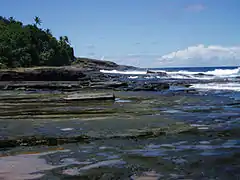
In 1972, the Le'alā Shoreline in Taputimu and Vailoatai was designated as a National Natural Landmark by the National Park Service. Le'alā Shoreline is a young flow of basalt, inter-bedded with layers of tuff that illustrates erosion by wave action. The site is covered with dense tropical vegetation.[40]
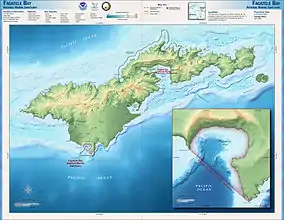
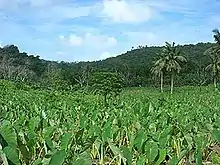
The Fogama’a Crater in Fūtiga and Vaitogi was also designated as a National Natural Landmark in 1972. Fogama'a Crater is one of very few illustrations of the most recent episode of volcanism in American Samoa.[41]
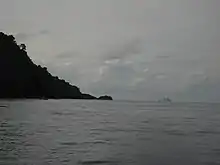
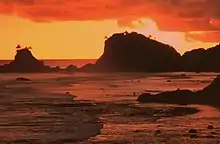
In 1986, Fagatele Bay National Marine Sanctuary in Fūtiga was designated by the National Marine Sanctuary Program.[42]
The Seumālō Ridge rises over 120 meters (400 feet) high along the western and northern sides of Fagatele Bay, while the eastern side of the bay is bounded by Manautuloa Ridge at over 60 meters (200 feet) high.[43]
In 2015, the Malaeloa Itū'au Olo Site was nominated for the National Register of Historic Places.[44] It is located 1.5 miles north of the junction of Malaeloa Road and Route 001, and it is comprised of a raised earth platform, with three lower levels of terraces, and two lunate-shaped moundsand trenches.
In 2018, the only landfill site in American Samoa - located in Fūtiga - was reported to have only two years left before it reached its limit. The American Samoa Power Authority (ASPA) was unable to find another site in the territory and instead began recompacting the site in Futiga. By digging up the landfill and recompacting it, the landfill may be usable for up to fifteen years longer.[45][46]
Notable People
Asuemu Ulufaleilupe Fuimaono (January 24, 1924 – September 9, 2008) was an American Samoan politician and Paramount Chief who served as American Samoa's first Delegate-at-Large to the United States House of Representatives from 1970 until 1974. Fuimaono also served as the Governor of Western District, American Samoa on the island of Tutuila from his appointment in 1993 until his death in 2008.
Eni Fa'aua'ā Hunkin Faleomavaega Jr. (August 15, 1943 – February 22, 2017) was an American Samoan politician who served as the territory's lieutenant governor and congressional delegate.
Fagaoalii Lefagaoali'i Sātele Sunia (c. 1946 – September 5, 2015) was an American Samoan literacy advocate and educator. She served as the First Lady of American Samoa from January 1997 to March 2003 during the tenure of her husband, former Governor Tauese Sunia, who died in office in 2003.
Demographics
| Year | Pop. | ±% |
|---|---|---|
| 1912 | 290 | — |
| 1920 | 333 | +14.8% |
| 1930 | 437 | +31.2% |
| 1940 | 527 | +20.6% |
| 1950 | 844 | +60.2% |
| 1960 | 1,008 | +19.4% |
| 1970 | 1,565 | +55.3% |
| 1980 | 2,171 | +38.7% |
| 1990 | 2,568 | +18.3% |
| 2000 | 2,987 | +16.3% |
| 2010 | 3,561 | +19.2% |
| U.S. Decennial Census[47] | ||
Tuālātai County was first recorded beginning with the 1912 special census. Regular decennial censuses were taken beginning in 1920.[48]
References
- 1987 Census of Agriculture: Geographic area series, Parts 55-56. Bureau of the Census. 1991. p. 4.
- Papali'i, A. M. S. (2002). ʻO si manu a aliʻi, a text for the advanced study of Samoan language and culture. United States: University of Hawaiʻi Press, page 425
- Tregear, E. (1891). The Maori-Polynesian Comparative Dictionary. Netherlands: Lyon and Blair.
- Pratt, G. (1862). Samoan Dictionary: English and Samoan, and Samoan and English, with a Short Grammar of the Samoan Dialect. American Samoa: London Missionary Society's Press.
- Papali'i, A. M. S. (2002). ʻO si manu a aliʻi, a text for the advanced study of Samoan language and culture. United States: University of Hawaiʻi Press, page 425
- Krämer, A. (2000). The Samoa Islands: An Outline of a Monograph with Particular Consideration of German Samoa. Constitution, pedigrees and traditions--. United States: University of Hawaii Press, Page 448.
- http://nzetc.victoria.ac.nz/tm/scholarly/tei-TuvAcco-t1-body1-d54.html
- http://nzetc.victoria.ac.nz/tm/scholarly/tei-TuvAcco-t1-body1-d54.html
- Williamson, R. W. (1967). The Social and Political Systems of Central Polynesia. Netherlands: Anthropological Publications, Page 82
- Turner, G. (1884). Samoa, a Hundred Years Ago and Long Before: Together with Notes on the Cults and Customs of Twenty-three Other Islands in the Pacific. United Kingdom: Macmillan, Page 189
- http://nzetc.victoria.ac.nz/tm/scholarly/tei-TuvAcco-t1-body1-d54.html
- https://paperspast.natlib.govt.nz/newspapers/STSSA18930624.2.8
- Shaffer, Robert J. (2013), American Samoa, 100 Years Under The United States Flag, Page 102
- Bulletin of the American Geographical Society of New York. (1913). United States: American Geographical Society.
- Simanu, Aumua Mata'itusi(2011). O Faia Fa'atumua O Samoa Mai Tala O Le Vavau, page 49
- Papali'i, A. M. S. (2002). ʻO si manu a aliʻi, a text for the advanced study of Samoan language and culture. United States: University of Hawaiʻi Press.
- Sunia, Fofo I.F. (2009). A History of American Samoa. Amerika Samoa Humanities Council. Page 35. ISBN 9781573062992
- Krämer, A. (2000). The Samoa Islands: An Outline of a Monograph with Particular Consideration of German Samoa. Constitution, pedigrees and traditions--. United States: University of Hawaii Press, Page 444.
- American Samoa, Hearings Before the Commission Appointed by the President of the United States ... September 18–20, 1930, at Honolulu, September 26–30, in American Samoa. (1931). United States: (n.p.), Page 160
- Milner, G. B. (1993). Samoan Dictionary: Samoan-English, English-Samoan. New Zealand: Polynesian Press, Page 142.
- Vaai, S. (1999). Samoa Faamatai and the Rule of Law. Samoa: National University of Samoa, Page 52
- Papali'i, A. M. S. (2002). ʻO si manu a aliʻi, a text for the advanced study of Samoan language and culture. United States: University of Hawaiʻi Press.
- Salua, F. S. F. T. (1995). O le tafatolu o au measina: Samoa. New Zealand: Department of Communication of the Presbyterian Church of Aotearoa New Zealand.
- Fai’ivae, Alex Godinet (2018). Ole Manuō o Tala Tu’u Ma Fisaga o Tala Ave. Amerika Samoa Humanities Council. ISBN 9781546229070.
- Ua Tālā le Ta'ui, Lomiga 1(2009), Page 25.
- Ua Tālā le Ta'ui, Lomiga 1(2009), Page 44.
- Sunia, Fofo I.F. (2009). A History of American Samoa. Amerika Samoa Humanities Council. Page 35. ISBN 9781573062992
- Soʻo, A. (2008). Democracy and Custom in Sāmoa: An Uneasy Alliance. Fiji: IPS Publications, University of the South Pacific, Page 16
- http://www.nplnews.com/fedregister/2015/2015-32375.pdf
- https://www.researchgate.net/publication/335291841_Malaeloa_Olo_US_National_Register_of_Historic_Properties_Accepted_1-5-2016
- Ua Tālā le Ta'ui, Lomiga 1(2009), Page 50.
- Sunia, Fofo I.F. (2009) A History of American Samoa. Amerika Samoa Humanities Council. Page 52. ISBN 9781573062992
- Lenihan, M. W. (1953). Betwixt the Here and There. United States: Dorrance.
- Brother Herman (1966). Tales of Ancient Samoa: Tala O Le Vavau. (n.p.): Association of the Marist Brothers' Old Boys
- Halloran, P. J. (1939). The Construction of the Samoan Library: Fagatogo, Tutuila, Samoa. United States: U.S. Government Printing Office.
- Sunia, Fofo I.F. (2009). A History of American Samoa. Amerika Samoa Humanities Council. Page 53. ISBN 9781573062992
- Wendt, M. A., Suaalii-Sauni, T. M. (2014). Whispers and Vanities: Samoan Indigenous Knowledge and Religion. United States: Huia Publishers.
- Gray, J.A.C. (1960). Amerika Samoa and its Naval Administration. Page 243.
- Sunia, Fofo I.F. (2009). A History of American Samoa. Amerika Samoa Humanities Council. Page 238. ISBN 9781573062992
- https://www.nps.gov/subjects/nnlandmarks/site.htm?Site=LESH-AS
- https://www.nps.gov/subjects/nnlandmarks/site.htm?Site=FOCR-AS
- https://web.archive.org/web/20070213222619/http://fagatelebay.noaa.gov/html/intro.html#Info
- https://sanctuaries.noaa.gov/science/condition/fbnms/history.html
- http://www.nplnews.com/fedregister/2015/2015-32375.pdf
- "American Samoa gets 'prettier' landfill". February 7, 2018 – via www.bbc.com.
- "American Samoa landfill gets an extension". RNZ. February 6, 2018.
- "U.S. Decennial Census". Census.gov. Retrieved June 6, 2013.
- https://www2.census.gov/prod2/decennial/documents/41084484v3ch10.pdf
